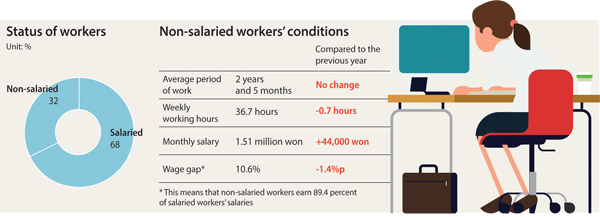Contract workers rise as Korea’s labor ‘dualism’ worsens

According to Statistics Korea Thursday, the number of non-salaried workers hit 6.15 million in March, up 144,000, or 2.4 percent, from the same period in the previous year. Those so-called non-regular workers accounted for 32 percent of the total number of paid employees in Korea.
Non-salaried workers worked an average of 36.7 hours a week and earned 1.51 million won ($1,278) a month. The wage gap ratio between staff and non-salaried workers was 10.6 percent. This means that non-salaried workers earn 89.4 percent of their on-staff counterparts’ salaries.
Salaried workers worked an average of 46 hours a week and earned 28.4 million won per month.
“Among the total number of non-salaried workers, people in their 50s accounted for 22 percent of the total, followed by people in their 60s and 40s,” said Shim Won-bo, a director at Statistics Korea. “In particular, the number of people in their 60s who are non-salaried workers rose 12.3 percent year-on-year.”
The data showed that non-salaried employees work for their companies for shorter periods. Non-salaried workers on average worked at their companies for 2 years and 5 months, while the figure was 7 years and 5 months for salaried workers.
By industry, the number of contract and temporarily workers rose in small businesses and manufacturing, while it fell in the retail and hospitality sectors.
In terms of education level, 44.1 percent of non-salaried workers were high school graduates. By sex, there were more female non-salaried workers than male. Female non-salaried workers accounted for 55.2 percent of the total as of March, and the number for females rose 4.2 percent year-on-year.
“People voluntarily choosing non-salaried jobs rose 8.2 percentage points year-on-year to 57.2 percent and 48.9 percent of those workers said they are satisfied with what they do,” said Shim. “78.3 percent of the people who didn’t choose to work in non-staff jobs said they had to because they were short of money.”
The total number of paid workers in Korea as of March reached 192.3 million, up 434,000, or 2.3 percent, from the previous year.
Meanwhile, the Organization for Economic Cooperation and Development (OECD) said labor market “dualism” in Korea - both salaried and non-salaried working populations - is exceptionally strong and that the share of non-salaried workers reached 22 percent, more than double the OECD average. The equivalent figure for Canada and Germany is 13 percent.
“Labor market dualism has resulted in high wage inequality and a relative poverty rate that is the eighth highest in the OECD,” the international organization said in a recent report.
BY KIM YOUNG-NAM [kim.youngnam@joongang.co.kr]










with the Korea JoongAng Daily
To write comments, please log in to one of the accounts.
Standards Board Policy (0/250자)